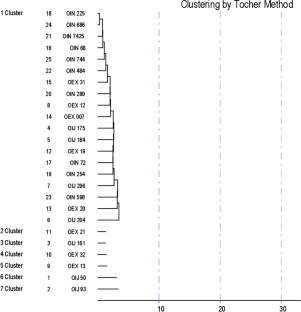Genetic diversity analysis by D2 clustering of yield and yield attributing traits in Jute (Corchorus olitorius) germplasm lines
Meena Jitendra Kumar, Bhandari Hem Raj, Mangal Vikas, Chourasia Kumar Nishant, Thribhuvan R., Kar Chandan Saurav, Mitra Jiban
Research Articles | Published: 30 July, 2021
First Page: 196
Last Page: 203
Views: 3927
Keywords: Cluster, Diversity, Mahalanobis D2 analysis, Tossa jute, Yield
Abstract
In the present study, genetic diversity analysis of twenty-five tossa jute genotypes consisting of 8 exotic (OEX, Exploration through NBPGR, New Delhi), 7 exotic (OIJ, Exploration through IJO, Dhaka) and 10 Indigenous types (OIN) was carried out at Central Seed Research Station for JAF(CSRSJAF), Budbud, West Bengal during Kharif, 2019. They were evaluated based on eight seed yield and their attributing traits to study the diversity array among the genotypes and grouped into five clusters through Mahalanobis’ D2 analysis. Cluster I was found largest with 19 genotypes and cluster II, III, IV, V, VI and VII comprising of only one genotype. Among the traits studied, seed yield contributed the maximum to the diversity (43.33 %) followed by plant height (24.67 %). The germplasm line OIJ 93 recorded the highest seed yield of 20.30 g per plant, while it recorded plant height 194 cm, base diameter 7.5 mm, number of primary branches per plant 2.20, number of pods per plant 18.30, pod length 6.30 cm, pod diameter 19.70 mm and number of seeds per pod 156.90. Cluster VII with an overall score of 21 across the 8 characters secured the first rank followed by clusters II, VI, III, V, IV and I. Cluster I has the highest intra-cluster distance (7.30), indicating that crosses involving genotypes within the same cluster may lead to good cross-combinations. It is hoped that genotypes will be selected from the clusters (clusters III and VII) that exhibit high inter-cluster distances for further crop improvement programs.

References
Adeyemo OA, Ayodele OO, Ajisafe MO, Okinedo UE, Adeoye DO, Afanou AB, Akinsemoyin FA, Ogunjobi OO, Kasali OJ, Chukwudiri EE (2021) Evaluation of dark jute SSR markers and morphological traits in genetic diversity assessment of jute mallow (Corchorus olitorius L.) cultivars. S Afr J Bot 137:290–297
Chuchert S, Nualsri C, Junsawang N, Soonsuwon W (2018) Genetic diversity, genetic variability, and path analysis for yield and its components in indigenous upland rice (Oryza sativa L. var. glutinosa). Songklanakarin J Sci Technol 40:609–616
Ghosh A, Biswas BK, Md A (2020) Variability and character association study in morphological traits of Tossa Jute (Corchorus olitorius L.). Agric 18:116–128
Ghosh T (1983) Plant production and protection paper. FAO, Rome
Jatothu JL, Kumar AA, Choudhary SB, Sharma HK, Maruthi RT, Kar CS, Mitra J (2018) Genetic diversity analysis in tossa jute (Corchorus olitorius L.) germplasm lines. J Appl Nat Sci 10:1–3
Kar CS, Kundu A, Sarkar D, Sinha MK, Mahapatra BS (2009) Genetic diversity in jute (Corchorus spp) and its utilization: A review. Indian J Agric Sci 79:575–586
Kavithamani D, Yuvaraja A, Selvi B (2019) Principal component analysis and grouping of sorghum (Sorghum bicolor L. Moench) gene pool for genetic diversity. Electron J Plant Breed 10:1426–1434
Kundu BC (1956) Jute - world’s foremost bast fibre, II. Technology, marketing, production and utilization. Econ Bot 10:203–240
Mahalanobis PC (1936) On the generalised distance in statistics. Proc Natl Inst Sci (India) 2:49–55
Majumder S, Saha P, Datta K, Datta SK (2020) Fiber crop, jute improvement by using genomics and genetic engineering. In: Taneja N (ed) Advancement in crop improvement techniques. Woodhead Publishing, pp 363–383. https://doi.org/10.1016/C2018-0-04179-1
Malviya N, Kumar K, Upadhyay D (2021) Genetic divergence in Indian mustard (Brassica juncea L. Czern. & Coss. Bangladesh Journal of Botany 50:37–44
Md RI, Akondo Md, Belal Hossain Md, Sefaur Rahman Md, Shamiul Haque Md, Azad Abul Kalam (2020) Screening of suitable tossa jute (Corchorus olitorius L.) mutant to increase fiber production. GSC Biol Pharm Sci 10:099–105
Miah A, Ranjan Saha N, Jahangir Alam M, Younus Ali M, Kumar Basunia A (2020) Characterization of Deshi Jute (Corchorus capsularis) Germplasm Collected from Different Sources. Acta Sci Agric 4:173–180
Miah A, Saha N, Ali M, Kamrujjaman M, Parvej M (2020) Assessment of genetic divergence of deshi jute (Corchorus capsularis) germplasms by using phenotypic characters. Progress Agric 31:10–18
Mir RR, Rustgi S, Sharma S, Singh R, Goyal A, Kumar J, Gaur A, Tyagi AK, Khan H, Sinha MK, Balyan HS, Gupta PK (2008) A preliminary genetic analysis of fibre traits and the use of new genomic SSRs for genetic diversity in jute. Euphytica 161:413–427
Mukul MM, Akter N, Mostofa MG, Rahman MS, Hossain MA-E, Roy DC, Jui SA, Karim MM, Ferdush J, Hoque MM, Mollah MAF (2020) Analyses of variability, euclidean clustering and principal components for genetic diversity of eight Tossa Jute (Corchorus olitorius L.) genotypes. Plant Sci Today 7:564–576
Ngomuo M, Stoilova T, Feyissa T, Ndakidemi PA (2017) Characterization of morphological diversity of Jute Mallow (Corchorus spp.). Int J Agron. https://doi.org/10.1155/2017/6460498
Rani DM, Moniruzzaman M, Nazrul IS (2018) Genetic variability study of tossa jute (Corchorus olitorius) genotypes. Int J Business social and Sci Res 6:52–55. https://doi.org/10.13140/RG.2.2.14721.35689
Rao CR (1952) Advanced statistical methods in Biometrical Research. John Wiley and sons, New York, p 328
Roy A, Hazari S, Bhattacharya S (2020) Analysis of comparative genetic diversity in two cultivated species of jute. Int J Curr Microbiol Appl Sci 9:221–230
Author Information
Crop Improvement Division, ICAR , Central Research Institute for Jute and Allied Fibres, Barrackpore, India